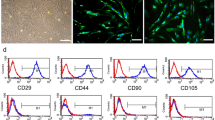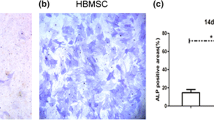Abstract
Mesenchymal stem cells (MSCs) have the potential for self-renewal and multipotential differentiation to regenerate damaged tissues or recover functional absence in diseases. Superparamagnetic iron oxide nanoparticles (SPIONs) are used as contrast agents in magnetic resonance imaging (MRI) for labeling cells in vitro and for tracking SPION-labeled cells after transplantation in vivo. Human amniotic membrane-derived mesenchymal stem cells (hAM-dMSCs) have the capacity for neuron-like differentiation that could be used to cure central nervous system (CNS) diseases. The study investigated the impacts of cytotoxicity of SPIONs on neuron-like differentiation of hAM-dMSCs in both single (1×) and multiple (4×) SPIONs-labeled methods. hAM-dMSCs could be efficiently labeled at safe concentrations of SPIONs (≤14 μg/ml) without significantly affecting their viability (>80% after a MTT assay), special surface antigens (CD29, CD44, CD90, CD105 through flow cytometry), and neuron-like differentiation (nestin and neuron-specific enolase through immunocytochemistry and reverse transcription polymerase chain reaction). Compared with multiple (4×) SPION-labeled methods, a single (1×) SPION-labeled method avoided multiple SPION-labeled hAM-dMSCs and minimized the impact of cytotoxicity of SPIONs on neuron-like differentiation of hAM-dMSCs. Under safe concentrations of SPIONs, a single (1×) SPION-labeled method provided appropriate viability for SPIONs-labeled hAM-dMSCs and facilitated the MRI evaluation of hAM-dMSCs after transplantation.






Similar content being viewed by others
Abbreviations
- MSCs:
-
Mesenchymal stem cells
- SPIONs:
-
Super paramagnetic iron oxide nanoparticles
- hAM-dMSCs:
-
Human amniotic membrane-derived mesenchymal stem cells
- MRI:
-
Magnetic resonance imaging
- CNS:
-
Central nervous system
- DMEM-LG:
-
Dulbecco’s modified eagle’s medium–low glucose
- bFGF:
-
Basic fibroblast growth factor
- NGF:
-
Nerve growth factor
- RA:
-
Retinoic acid
- CGM:
-
Cytokine growth medium
- CIM:
-
Cytokine induction medium
- RT-PCR:
-
Reverse transcription polymerase chain reaction
- MTT:
-
3-[4,5-Dimethylthiazol-2-yl]-2,5-diphenyltetrazolium bromide
- NSE:
-
Neuron-specific enolase
- GFAP:
-
Glia fibrillary acid protein
References
Kern S, Eichler H, Stoeve J et al (2006) Comparative analysis of mesenchymal stem cells from bone marrow, umbilical cord blood, or adipose tissue. Stem Cells 24:1294–1301
Ishige I, Nagamura-Inoue T, Honda MJ et al (2009) Comparison of mesenchymal stem cells derived from arterial, venous, and Wharton’s jelly explants of human umbilical cord. Int Hematol 90:261–269
Brohlin M, Mahay D, Novikov LN et al (2009) Characterisation of human mesenchymal stem cells following differentiation into Schwann cell-like cells. Neurosci Res 64:41–49
Khoo ML, Shen B, Tao H et al (2008) Long-term serial passage and neuronal differentiation capability of human bone marrow mesenchymal stem cells. Stem Cells Dev 17:883–896
Crigler L, Robey RC, Asawachaicharn A et al (2006) Human mesenchymal stem cell subpopulations express a variety of neuro-regulatory molecules and promote neuronal cell survival and neuritogenesis. Exp Neurol 198:54–64
Chao YX, He BP, Tay SS (2009) Mesenchymal stem cell transplantation attenuates blood brain barrier damage and neuroinflammation and protects dopaminergic neurons against MPTP toxicity in the substantia nigra in a model of Parkinson’s disease. J Neuroimmunol 216:39–50
Wolbank S, Stadler G, Peterbauer A et al (2009) Telomerase immortalized human amnion- and adipose-derived mesenchymal stem cells: maintenance of differentiation and immunomodulatory characteristics. Tissue Eng 15:1843–1854
Wang GP, Yang B, Guan FX et al (2008) Treatment of brain injured rats through transplanting amniotic-derived mesenchymal stem cells in different ways. Zheng Zhou Da Xue Xue Bao Yi Xue Ban 33:926–930 (in chinese)
Marcus AJ, Coyne TM, Black IB et al (2008) Fate of amnion-derived stem cells transplanted to the fetal rat brain: migration, survival and differentiation. J Cell Mol Med 12:1256–1264
Han K, Lee JE, Kwon SJ et al (2008) Human amnion-derived mesenchymal stem cells are a potential source for uterine stem cell therapy. Cell Prolif 41:709–725
Weissleder R, Cheng HC, Bogdanova A et al (1997) Magnetically labeled cells can be detected by MR imaging. Magn Reson Imaging 7:258–263
Daldrup-Link HE, Rudelius M, Piontek G et al (2005) Migration of iron oxide-labeled human hematopoietic progenitor cells in a mouse model: in vivo monitoring with 1.5-T MR imaging equipment. Radiology 234:197–205
Pawelczyk E, Arbab AS, Chaudhry A et al (2008) In vitro model of bromodeoxyuridine or iron oxide nanoparticle uptake by activated macrophages from labeled stem cells: implications for cellular therapy. Stem Cells 26:1366–1375
Li GX, Yang B, Guan FX et al (2006) Isolation, culture and identification of human amniotic-derived mesenchymal stem cells. Zhengzhou Daxue Xuebao 412:244–246 (in Chinese)
Pittenger MF, Mackay AM, Beck SC et al (1999) Multilineage potential of adult human mesenchymal stem cells. Science 284:143–147
Lu FZ, Fujino M, Kitazawa Y et al (2005) Characterization and gene transfer in mesenchymal stem cells derived from human umbilical-cord blood. Lab Clin Med 146:271–278
Lee RH, Kim B, Choi I et al (2004) Characterization and expression analysis of mesenchymal stem cells from human bone marrow and adipose tissue Cell. Physiol Biochem 14:311–324
Alviano F, Fossati V, Marchionni C et al (2007) Term amniotic membrane is a high throughput source for multipotent mesenchymal stem cells with the ability to differentiate into endothelial cells in vitro. BMC Dev Biol 7:11
Zhao P, Ise H, Hongo M et al (2005) Human amniotic mesenchymal cells have some characteristics of cardiomyocytes. Transplantation 79:528–535
Mahmood A, Lu D, Qu C et al (2006) Long-term recovery after bone marrow stromal cell treatment of traumatic brain injury in rats. J Neurosurg 104:272–277
Heile AM, Wallrapp C, Klinge PM et al (2009) Cerebral transplantation of encapsulated mesenchymal stem cells improves cellular pathology after experimental traumatic brain injury. Neurosci Lett 463:176–181
Song S, Zhang H, Cuevas J et al (2007) Comparison of neuron-like cells derived from bone marrow stem cells to those differentiated from adult brain neuron stem cells. Stem Cells Dev 16:747–756
Fallahi-Sichani M, Soleimani M, Najafi SM et al (2007) In vitro differentiation of cord blood unrestricted somatic stem cells expressing dopamine-associated genes into neuron-like cells. Cell Biol Int 31:299–403
Zborowski M, Chalmers JJ (2007) Magnetic cell separation. Elsevier, Amsterdam, p 32
Acknowledgments
This research was supported by Henan Medical Science and Technology Research Projects of Health Department of Henan Province, People’s Republic of China (No. 200702003); Henan Medical Technological Innovation Projects of Health Department of Henan Province, People’s Republic of China (No. 2005018).
Conflict of interest
The authors state no conflicts of interest.
Author information
Authors and Affiliations
Corresponding author
Rights and permissions
About this article
Cite this article
Zeng, G., Wang, G., Guan, F. et al. Human amniotic membrane-derived mesenchymal stem cells labeled with superparamagnetic iron oxide nanoparticles: the effect on neuron-like differentiation in vitro. Mol Cell Biochem 357, 331–341 (2011). https://doi.org/10.1007/s11010-011-0904-4
Received:
Accepted:
Published:
Issue Date:
DOI: https://doi.org/10.1007/s11010-011-0904-4




